Photos: Kip Miller
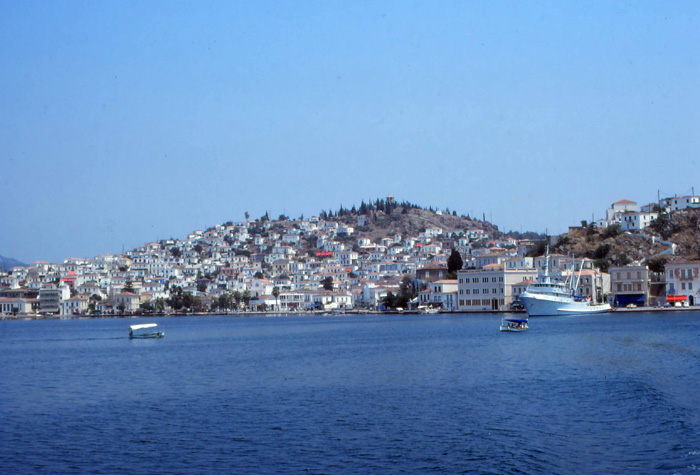
The Spetses waterfront spreads over the northeast corner of the island, a mashup of several neighborhoods.
It's 1979 and we are planning our fifth trip to Greece. I have just finished
reading "The Magus" by John Fowles, the postmodern novel that
came out in 1965 and later ranked among Modern Library's 100 best novels.
I am intrigued by the story, doubly so because my husband and I have seen
the film version made in 1968, with Michael Caine starring as the British
Oxford graduate Nicholas Urfe, an aspiring poet who has taken a teaching
post at the exclusive Lord Byron School, and the "honorary Greek"
Anthony Quinn as the millionaire Maurice Conchis who involves Urfe in
a series of sexual and psychological games. Their island is called "Phraxos."
Of course the film was not actually filmed in Spetses, but rather in Mallorca,
and truth be told, it wasn't the best of films. But the story is based
on the author's time spent in Spetses and his teaching stint at the Anargyrios
and Korgialenios Prep School that is modeled after the famous British
schools of Eton and Harrow.
Since we
are bringing Jeremy and Alison, our young children, as well as parents
along, the proximity of Spetses to Athens is a definite plus. And with
six people traveling, the $298 per person roundtrip charter airfare from
New York is hard to pass up. We arrive in Athens a little behind schedule,
hoping that we won't miss our hydrofoil connection to Spetses, the last
one scheduled that afternoon. A Greek friend had promised that his brother
would be waiting to take us to Zea Marina harbor. We deplane and wait
patiently for our ride, but no one has shown up. My father, who is always
extremely punctual, is getting anxious. I scan a line of taxis thinking
we should grab one. Suddenly, a battered grey sedan pulls up. The young
driver apologizes profusely and crams our luggage into the trunk and atop
the roof as we pile inside. We have only minutes to make it to Zea Marina.
The car races ahead, crashing through lights and stop signs, swerving
over corners, finally screeching to a halt near the last hydrofoil bound
for Spetses. Our breathless driver smiles proudly, satisfied that he beat
the odds. "Efharistóume, pára polí (thank you
very much)," I shout and wave as we climb aboard.
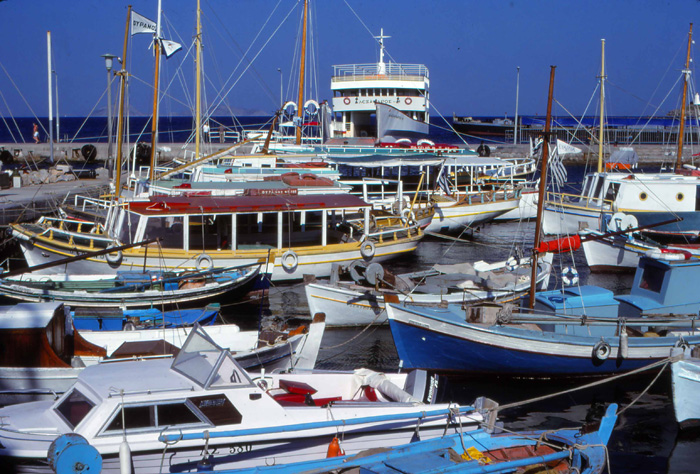
Crowded with pleasure craft and caïques, Dapia is also where ferries, hydrofoils and most visitors arrive.
It's about a two-hour crossing to Spetses. We zoom ahead of a large ferry as we turn toward the Argosaronic islands of Aegina, Poros and Hydra. All at once Spetses comes into view, its rambling waterfront spreading before us. I notice that there are two main harbor areas, both teeming with activity. "This won't be an easy town to nail down," I mumble as I scan the line of water taxis and pleasure craft bobbing in Dapia harbor. Dominating the area on the right is the massive Poseidonion Hotel, dating from the turn-of-the century. "Wow, that's quite a building!" exclaims my husband. "It looks as if it has been plucked straight out of the French Riviera! Yes, I think we are going to have lots of fun here," he remarks as we disembark and search for an empty taxi.
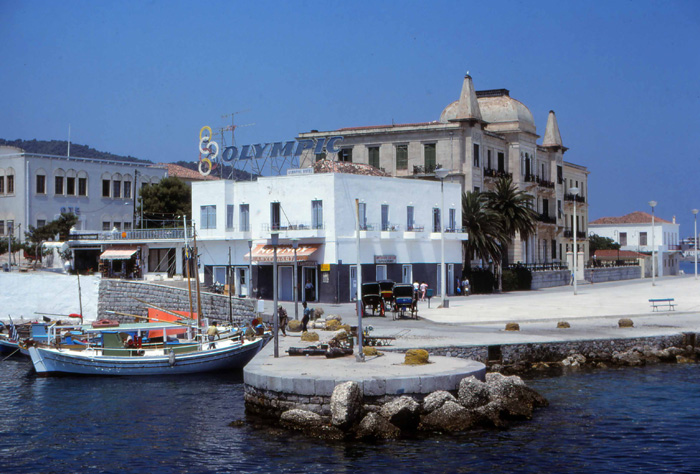
The massive Poseidonian Hotel dominates the harbor area. Its grand opening in 1914 marked the beginning of Greek island tourism.
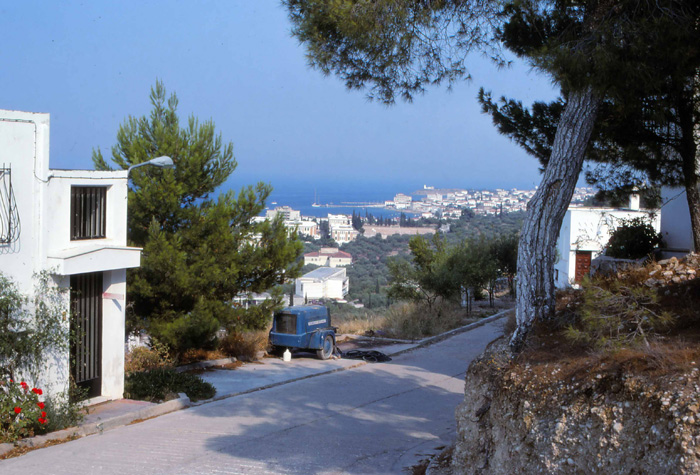
Northwest of Spetses town is Ligonéri, a residential enclave of modern townhouses with panoramic views of the coastline.
On the northwest coast above Spetses town is Ligonéri, a small
residential enclave with views to the sea where are renting a three-bedroom
townhouse from a Mrs. Pangalos. When we made the rental arrangements through
the travel office of the Grande Bretagne Hotel, I was stunned to learn
that she is part of an illustrious Athenian family whose patriarch, Theodoros
Pangalos had been a decorated soldier, statesman, and a short-term dictator,
and whose current paterfamilias is a prominent member of PASOK, the party
of Andreas Papandreou. Of course we did not dare ask too many questions,
respecting her privacy. "Aren't we lucky!" smiled my husband,
thrilled to have found enough space for the right price.
The only vehicles permitted in Spetses town are buses, service trucks, and a few taxis. Locals and tourists manage to get around on horse-drawn carriages, motor bikes, bicycles, and on foot. We can't wait to explore the island and its unique neighborhoods, but also include plenty of beach time for the kids. Time permitting, we even hope to make a day trip to the mainland and neighboring islands. "Please, let's not go to town until evening," begs my mother who is an avid walker but is exhausted after the long trip from New York. We all take naps, lulled by the sound of the sea and the scent of jasmine drifting through our open windows.
The evening bus drops us near Dapia, the town's fashionable center distinguished by black-and-white pebble mosaic paving and lined with cafes and bars. The area is jam-packed with well-dressed locals taking their leisurely volta (promenade), a daily ritual here. They gather like clockwork to see and be seen and it is fun to just sit and watch them circulate. Dapia means fortified town in Turkish and at the end of the quay a row of aged bronze cannons point seawards, relics of Greece's War of Independence. Across the channel on the mainland is Kosta, only four kilometers away. We continue to the square behind the Dapia containing a bust of Lascarina Bouboulína, the local heroine. Bouboulína is a household name in Greece and her brave deeds are commemorated at the island's annual "Armata," an event which takes place around the 8th of September. The week-long celebration commemorates the uprising of the Greeks against their Ottoman oppressors, culminating in a Saturday night reenactment of a decisive naval battle. A model enemy ship built just for the occasion is blown up in the sea, followed by a tremendous fireworks display. "People come from all over Greece to see the Armata," I explain to the family, sneaking a sideways glance at several incongruous sphinxes that decorate the facade of a mansion behind us. "I want to hear more about Bouboulína!" begs Alison.
"She is a national heroine," I read out loud from our guidebook. "Bouboulína was born in a Turkish prison where her father was imprisoned his revolutionary activities. After his death, Bouboulína's mother took her to their native Hydra, and later to Spetses. When her second husband, a sea captain, was killed in a battle against pirates, Bouboulína took command of his fleet became a member of the Filiki Etairia, a secret revolutionary society organized to resist the Turks. Along with the islands Psará and Hydra, Spetses was the first the respond to the revolutionary call. Using the fortune left by her two husbands, she built the island's great warship, Agamemnon. On March 3, 1821, she raised her own flag on the ship, declaring 'Elefthería y Thánatos' (freedom or death) and participated in several battles during the war. Unfortunately, she was killed by a stray bullet during a family feud in 1826." "Wow, she was one brave lady!" grins my father. Just then, a dapper, mustachioed man who must have overheard us approaches from behind. "You would be interested to know that there are plans to create a museum to honor Bouboulína. It will be housed in her husband Bouboulis's old residence nearby," he explains. "But it will take years for it to be finished." "Darn, why isn't it here now!" I complain, hoping we can return one day to see it.
It is nearly
nine o'clock and everyone is famished. We head toward the Kounoupítsa
neighborhood to Patralis, a restaurant that had been highly recommended
by friends. This popular fish taverna was founded by an old Spetsiot family
back in 1935. It overlooks the sea and offers a huge selection of seafood
and Greek classics. Alison and Jeremy order from the kid's menu, but we
select the house speciality, Psári a la Spetsióta -- delicate
sea bream cooked with tomatoes, onions, and herbs with a dash and wine.
Vasilis, the current head of the Patralis family, is delighted that we
are pleased with our fish and brings over a plateful of the house amygdálota
to sample. They are pear-shaped almond confections scented with rosewater
and covered with powdered sugar. "Now you will always remember Spetses!"
he smiles as we make them disappear.

Among the island's beautiful beaches is Zogeriá, a broad sweep of smooth grey pebbles lapped by a limpid turquoise sea.
During the following days we visit several beaches with the kids. Our
very favorite is Zogeriá, located not far from our townhouse in
Ligonéri. Here smooth grey pebbles are lapped by a limpid turquoise
sea, and trees grow almost to the water's edge. Spetses is considered
a green island and in ancient times it was called Pityoussa, meaning pine-covered.
But other trees also thrive: olive, pistachio, fig and myrtle, and many
island buildings and walls are draped in bougainvillea and wisteria. Under
the pines an herbal carpet of thyme, rosemary and marjoram grows in abundance.
Somehow, in spite of wildfires that often break out during hot summer
months, Spetses manages to remain green. "Please, can we stay here
all day?" the kids plead. And so we linger for several blissful hours,
sheltered under tree shade, with frequent forays into the sea.
Water taxis
depart Dapia continuously for other Spetses beaches. The world feels right
as we zoom toward Agioi Anárgyroi, a pebble beach on the southern
side of the island with a fringe of vegetation touching the water. Nearby
is Bekiris's cave, a secret spot where Spetsiots hid out during the Revolutionary
War and whenever pirates attacked. On the feast day of Agía Marina,
a saint whose name day is celebrated on July 17, we board a bus heading
south past the old harbor area to a beach near the Agía Marina
church. It's a joyous, raucous scene: local families are lounging on blankets
or are seated around tables under the trees, lambs are turning on spits,
and young men are darting around serving drinks while musicians play a
medley of traditional and pop Greek tunes. We enjoy a long, leisurely
afternoon meal ending with locally-grown karpoúzi (watermelon).
"This is the best watermelon I have ever had," proclaims my
father as he reaches for the last remaining slice. We sit back and close
our eyes. About ten minutes later, I suddenly notice that Jeremy is missing
at the table. We search for him everywhere, but he is not to be found.
Just as panic begins to set in, a local woman approaches, waving her arms.
"To paidí sas eínai kleidoméno sto bánio"
(your child is locked in the bathroom), she admonishes me. As we rush
toward the public toilets we can hear Jeremy's frantic banging and screaming
from afar: "Get me out of here! The door won't open!" In no
time my technically adept husband unjams the door, returning Jeremy to
the table unscathed. "Do you think they have ice cream?" he
asks with a sweet smile, his little trauma completely forgotten.
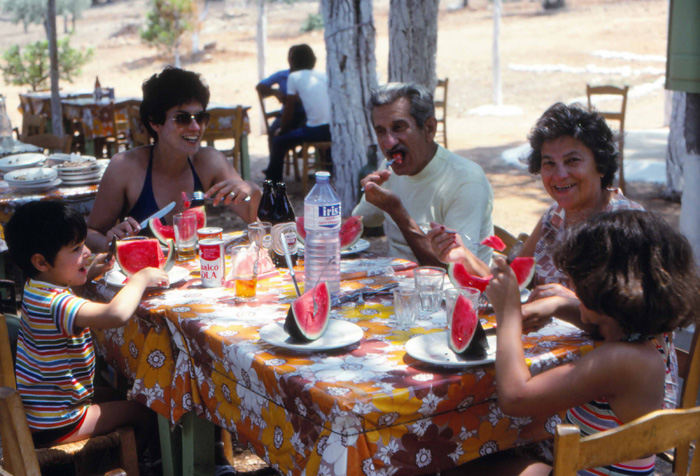
Our leisurely afternoon lunch at Agia Marina beach includes flavorful watermelon harvested from nearby fields.
We grab a taxi for a quick spin around the island's southern shoreline.
Just beyond Agia Marina is an exclusive area lined with high walls and
greenery shielding large estates owned by some of Greece's shipping and
banking elite. "Wow, check out those yachts over there!" says
my father who has always enjoyed looking at boats. Some of these undoubtedly
belong to non-Greek nouveau riche who come to Spetses in season to be
seen and to party. We gaze at the cobalt sea beyond. It is mirror smooth,
not a ripple in sight. Here lies tiny Spetsopoula, the pine-forested,
private island purchased in 1962 by shipping magnate Stavros Niarchos,
the arch rival of Aristotle Onassis. Hidden in a pine forest stocked with
pheasants and partridges is his magnificent 15-room villa, complete with
separate guest quarters. It was on this fabled isle that Niarchos's third
wife, the beautiful but troubled Eugenia Livanos, died under very mysterious
circumstances.
On days that
the kids and my parents take afternoon naps, we stroll downhill into town.
Off the road just below Ligonéri sprawls the infamous Anargyrios
Korgialenios School, opened in 1923. Almost hidden from view behind stands
of cypress and olive trees, the campus includes a stadium and observatory,
an amphitheater, tennis courts, dormitories and classrooms. Another enterprise
of the island philanthropist Sotirios Anargyrios, it was financed in collaboration
with a bequest from another wealthy Spetsiot, Marinos Korgialenios, under
the patronage of the then-King of Greece. Anargyrios had made an enormous
fortune in tobacco trade in America, and upon returning to Spetses, he
became its greatest benefactor, leveraging his assets to improve the island's
infrastructure -- from building roads and an aqueduct to supply fresh
water to the town, to an enormous reforestation project to replenish the
island's hillsides, severely depleted after centuries of shipbuilding
in the old harbor yards. When his lavish Poseidonion Hotel was completed
in 1914, it became the very first hotel to open on any Greek island, jump-starting
tourism by immediately attracting wealthy Greeks and European aristocracy.
We continue past the silent campus. "It's so eerily quiet here,"
I murmur. "But you're not listening," says my imaginative husband.
"The wind is whispering secrets about the all the shenanigans that
went on here!"
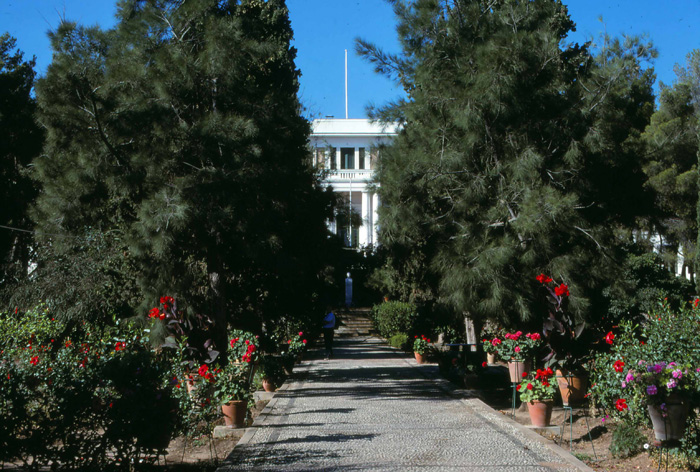
The campus of the Anargyrios-Korgialenios School nestles amid pines and cypresses. "The Magus" by John Fowles is based on the author's time spent teaching at the school.
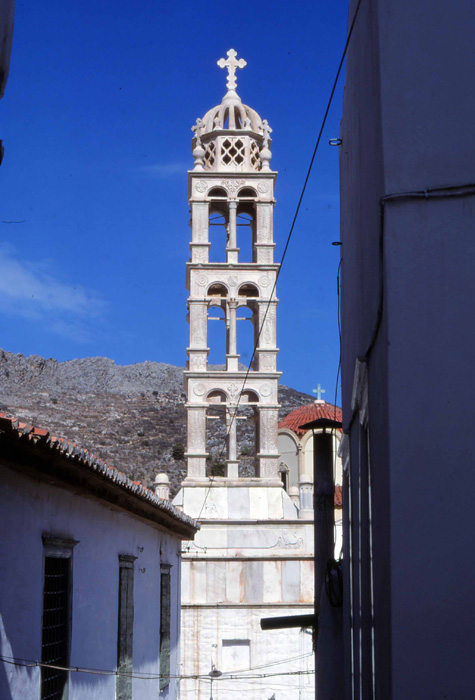
The marble bell tower of St. Nicholas is visible from afar. It was here that the flag
of Spetses was raised on April 3, 1821, launching Greece's War of Independence.
Dapia is calmer during the afternoon siesta. Minus the crowds we are able to admire its mosaic pavement depicting the flag of Spetses. We continue south along the sea toward to the fish market area, passing by the harbormaster's house and the quaint small church of Agios Mamas. Facing the sea are clusters of archontiká, elegant 18th and 19th century captain's houses shielded by high walls. A couple of gates are ajar and we peek inside to discover gardens fragrant with honeysuckle and hibiscus, tiny grape arbors and rows of vegetables. At the entrance of the old harbor, dominating a small headland, is the metropolitan church of Agios Nikolaos, patron saint of the island, visible from afar due to its towering white marble bell tower. "This church is where the struggle for independence against the Turks began," I remind my husband. "The Spetses flag was proudly hoisted high atop the campanile on April 3, 1821, and Greece never looked back." A massive pebbled courtyard fronts the church, serving as a staging area for dances and processions that mark various religious and civic holidays throughout the year. "During the war the body of Napoleon's nephew, Paul, was stored here in barrel of rum," I read from my guidebook. "He was a passionate philhellene who came to Greece to participate in the liberation, but he was accidently killed. Five years later he finally received a proper burial in Navarino!"

In the Old Harbor, a row of octopuses dry in the sun, luring us to Haralambos's fish taverna.
Beyond the promontory of Agios Nikolaos is Baltiza Bay, a marshy area
that leads to a deep inlet in the coastline shielding the island's Old
Harbor, a colorful spot crowded with pleasure craft, locally made caïques,
and a couple of cargo ships. Clinging to centuries of local tradition,
a few shipyards remain operational, providing employment for many islanders.
Until recent decades, shipbuilding on Spetses was a common occupation,
with ample wood supplied by its Aleppo pine forests. Today all the lumber
comes from Samos, a large wooded island off the Turkish coast. As we stroll
through the shipyards, our eyes are drawn to a row of octopuses drying
in the sun next to Haralambos's Taverna. The scent of sizzling kalamária
wafts from within, whetting our appetites. "Let's eat," we proclaim
simultaneously, grabbing a tiny corner table. In no time a platter of
kalamária arrives, all crispy and fragrant, with chunks of lemon
to squeeze and country bread to mop up the dregs. Next to us, a group
of exuberant shipwrights are polishing off a line-up of beers and platefuls
of octopus, marídes (whitebait) and fries. They erupt into bouts
of boisterous laughter as they share stories about the good old days,
undoubtedly exaggerated, backslapping and clinking their glasses repeatedly.
Like many tourists who visit Spetses, we are curious about its literary landmarks, namely the infamous Magus House (Villa Yasemía), situated northwest of Profitis Elias, the island's highest point, off a lonely road not far from Agía Paraskeví beach. Late one afternoon, we follow a stony goat track with markers for the villa. Rising high on a promontory, Yasemía is a standout, built on the site of a former monastery, its white exterior set off by Moorish arches and Romanesque windows. We pause in front of its imposing gate (in "The Magus" the villa was called Bourani). Near here Urfe lost his way in a pine forest, lured by the mind games of Conchis and the incongruous sound of a harmonium. Today's villa Yasemía is owned by the Botassis family and is not open to the public, a pity since it is supposed to be filled with relics from the War of Independence. We stop to rest. "Wow, what a magical spot!" sighs my husband. The breeze rustles through the surrounding pines as cicadas buzz noisily, but the sea shimmers in total silence. I suddenly have an "aha" moment: No wonder Nicholas Urfe found Phraxos (Spetses) so breathtakingly beautiful -- "floating like a majestic black whale in an amethyst evening sea!"
After a week,
the kids are totally sated with beach days and willing to explore the
town. We start out at Dapia again, heading to the Anargyrios Mansion that
I had noticed on our first day. Completed in 1904, it is built in high
neoclassic style with exotic touches that give it an Egyptian vibe. Unlike
other buildings in Spetses that are fashioned entirely of stone, it is
made out of concrete and iron, with classical door frames and pediments,
and even some details that evoke antebellum mansions in America, probably
visited by Anargyrios during his years there. Not far away is Plateía
Rologioú (Clocktower Square) dating from 1915, and a little beyond
is the official Spetses Museum, housed in the Hadji-Yannis Mexis residence.
Compared to the Anargyrios Mansion it is much more austere, with some
Ottoman influences, because Mexis had made a pilgrimage to Jerusalem once
and was named "Nazir of Spetses" by the Sultan of that time.
We wander inside, past interesting antiquities, maritime memorabilia,
old photographs and ship figureheads. But I am most drawn to a casket
in the former women's room containing the bones of Bouboulína!
Draped above it is the flag of Spetses. It would be so fun to have a little
dog named Bouboulína!" sighs Alison, still intrigued by the
local heroine.
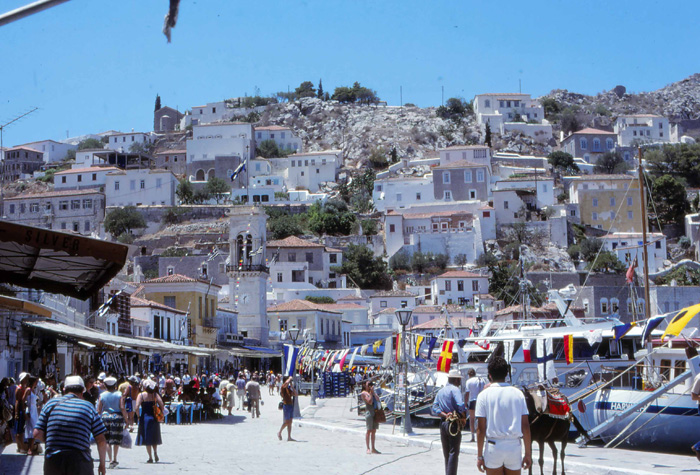
Tucked beyond crowded Clocktower Square is the Museum of Spetses, housed in the historic Hadji-Yannis Mejis Museum.
Inland near Analipsis Square is Klimatariá, a family restaurant
with tables under tree shade and a reputation for homestyle cooking. We
order up our favorite Greek comfort foods: a creamy moussaká, meatballs
and fries for the kids, stuffed grape leaves, a generous Greek salad and
a plate of tzatzíki. Behind the restaurant is a small garden and
I have no doubt that all the vegetables and herbs in our selections were
freshly picked that morning. We sit back, read, and relax while the kids
play word games and my parents doze off. Late in the afternoon, we blend
into a crowd of locals taking their daily vólta. With lunch a distant
memory, we're eager to partake in the Greek custom of a pre-dinner sweet.
The aroma of dough and cinnamon lures us to Klimis's Zacharoplastíon
(pastry shop), renowned on the island for excellent loukoumádes
(fried doughnut balls doused with honey). They also make their own version
of amygdálota and offer a lineup of ice cream creations. The warm
loukoumádes do not disappoint, and Jeremy and Alison are overjoyed
with waffle cones packed with chocolate and vanilla.
Later that
night, when the kids and my parents are sound asleep, we return to town,
having promised ourselves a bouzoúkia night at George's, a night
club located well out of earshot of Spetses's residential areas. We arrive
at midnight, surprised that there are no other customers. By one o'clock,
people start straggling in and the band begins to tune up. By three the
place is packed and the crowded dance floor vibrates as a line-up of pop
singers take turns at the microphone. The music is a mix of old and new,
with traditional instruments such as bouzoúki and claríno,
but also drums and an acoustic guitar. Nearly all the clientele is Greek,
most likely Athenian. Everyone is having a raucous good time. It's almost
six in the morning when the music finally dies down. As the sun rises,
George's is dead silent again. A slight breeze ripples through clusters
of night-blooming jasmine draped over garden walls as we ascend a narrow
back street toward Ligonéri. We slip silently into bed, exhausted
but elated. "I don't think that anyone even noticed we had been gone,"
I tell my husband hours later.
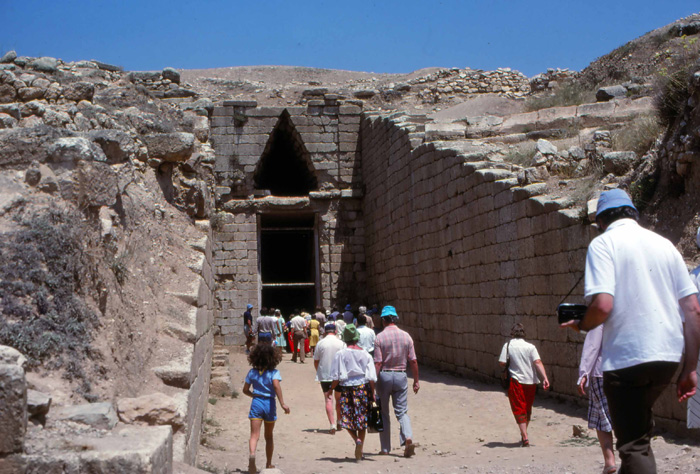
A crowd of tourists head to Mycenae's beehive tomb.
Spetses is only a few kilometers off the Argolid Peninsula. "It's so close, we have to go there!" I convince my mother as we sign up for a day trip that begins at Mycenae and Nafplion, followed by stops at the islands of Hydra and Poros. It's a hot and windy day as we trail behind a horde of tourists filing through Mycenae's iconic Lion's gate toward to the site's beehive tomb. Together with Troy, Mycenae catapulted to fame thanks to Heinrich Schliemann, a passionate amateur archaeologist whose discoveries placed Greece on European itineraries forevermore, spurring further excavations throughout the Mediterranean. "Very cool," says Jeremy inside the tomb. "Did they find lots of bones here?" About 90 minutes later we are ascending the citadel on Palamidi Hill overlooking the historic town of Nauplion, where the first government of Greece was headquartered after the War of Independence. In the middle of the azure bay rises tiny Bourtzi, a castle built by the Venetians in the 15th century. It was here that Kolokotronis, the hero of the War of Independence, was briefly imprisoned, having been accused of treason. "Bouboulína was involved in the blockade of Nauplion during the War," I inform the family. Our guide leads us back to the tour boat which departs for Hydra, a sister island, known for exquisite architecture from bygone days. After lunch on the waterfront, we explore its compact harbor, pausing by a rocky promontory where several muscular youths are diving into the sea below. The tour ends with a short stop at Poros, a green island covered with pines and a forest of lemon trees. We browse through its quaint shops, finding some traditional copperware, perfect for hanging on our kitchen wall at home. It's almost twilight when we pull into Dapia. A large ferry is disgorging passengers, reminding us that we will be departing for Athens in the morning.
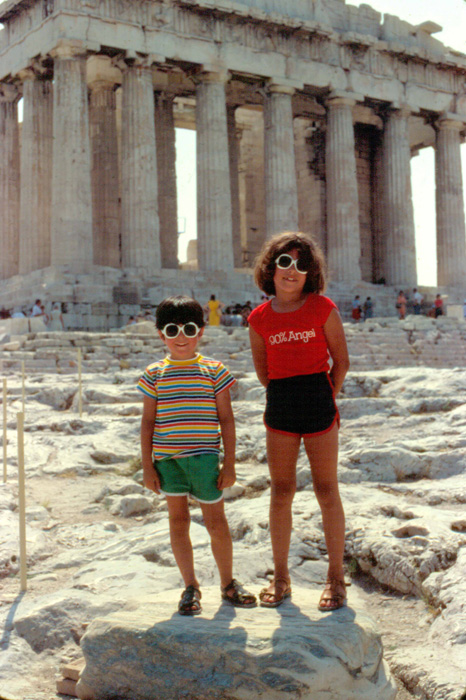
Young as they are, the kids seem to grasp the significance of the Acropolis.
On our last day in Greece, we climb the Acropolis with Alison and Jeremy, leaving my parents to rest at the hotel. Young as they are, the kids seem to grasp the significance of the site and are as excited as we were back in 1969 when we stood awestruck in front of the Parthenon for the very first time! At the National Historical Museum in the Old Parliament on Stadiou Street, we stop to peruse a painting of Bouboulína by Peter Van Hess. She is standing on one of her ships, her face determined, a gun tucked into her waistband, the first and maybe only female admiral in the entire history of the world. "What a role model," says my husband.
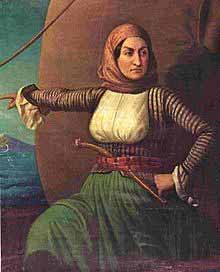
At the Athens National Historical Museum, a painting of Bouboulina
by Peter Van Hess captures her courage and resolve.
POSTSCRIPT 2019: Spetses has undergone many changes during the past four
decades. The Poseidonian Hotel closed in 2003 for a complete renovation,
reopening in 2009. Still retaining its architectural integrity and old
world charm, it now offers every conceivable modern amenity plus the refined
cuisine of a world-class chef. Accordingly, The Poseidonian was recently
named "Best Classic Boutique Hotel in Europe." A dramatic bronze
sculpture of Bouboulína by Athenian artist Natalia Mela was erected
in 1985 on the esplanade in front of the hotel. The Anargyrios-Korgialenios
School ceased operations as a school in 1983 but reopened three years
later as a state-of-the-art international conference facility, attracting
companies and organizations from all over the world. The Bouboulína
Museum officially opened in 1991, organized by a foundation headed by
a fourth generation descendant, Philip Demertzis-Bouboulis. As of today,
more than a million tourists have viewed the museum's rich collection
of model ships, old weapons, rare books and manuscripts, and many of Bouboulína's
personal items. Despite devastating fires that erupted on the island during
the 1990s and Greece's recent economic downturn, Spetses has managed to
remain prosperous. New events such as an international yacht regatta,
"Tweed Run" -- a cycling competition on antique bikes, and a
"Spetsathlon" sporting competition have helped Spetses to brand
itself as "an island apart."
